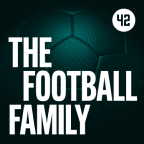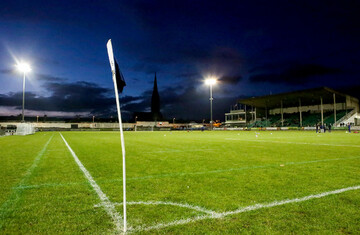WHEN IT COMES to producing elite male footballers, no county in Ireland underperforms to Limerick’s extent.
While Don Givens and Steve Finnan were born in Limerick, they grew up in Dublin and England respectively, and so were formed in different systems. From our research, it appears the last player to come through Limerick’s underage soccer ranks to play competitively at senior men’s level for Ireland is Al Finucane, who won the last of his 11 caps in 1971.
There have been other fine careers: Johnny Walsh made a friendly appearance against Trinidad in 1982, Willie Boland played in the Premier League and up to U21 international level, while a smattering of other Limerick players have carved out solid professional lives in England. (Dara Costelloe, John Ryan, Anthony Forde, Ronan Coughlan, and Paudie O’Connor are doing so now.)
But the topline statistic is staggering: Limerick last produced a senior international for a competitive Irish match fifty-four years ago.
Other counties have underachieved under this metric too, but on the surface, few have the advantages Limerick has. It is the sixth-largest county in the Republic by population; is a city in which football is played widely; houses the standard-setting facilities and expertise of the University of Limerick; and has a superb tradition across all sports, arguably punching above its weight in rugby and hurling over the last couple of decades.
But when it comes to the production of elite soccer players, it’s a national black spot.
How has this happened?
**********
We spoke with six people who have direct working experience of football in Limerick, at all levels. They all preferred to remain anonymous, so as to be able to speak more freely. In addition, we spoke with Dave Mahedy, who retired as the director of sport and recreation of UL in 2019, a role he held for 34 years.
He is uniquely positioned to give insight on the subject: he worked at UL following a remarkable career of success across multiple sports, which included assistant roles at Limerick FC and St Patrick’s Athletic (across which he won three league titles and an FAI Cup) along with spells working with Munster Rugby – with whom he won two Heineken Cups – and the Limerick hurlers, whom he helped to two Munster championships in the 1990s.
“It’s a bottom-up issue,” he tells The 42, ”but also a top-down issue.”
Let’s start with the top-down issue.
The turbulence that has afflicted Limerick’s senior soccer team since the early 1980s is notable even by the League of Ireland’s fasten-your-seatbelt standards.
Since Limerick United won the top-flight title in 1980, the main club has been known as Limerick City, Limerick 37, Limerick FC, and now Treaty United. They have roved about Limerick looking for a home, and their only major prizes since winning the FAI Cup in 1982 have been a pair of League Cups.
And while the LOI team has struggled for years, the standard of adult amateur football in Limerick is widely acknowledged as very strong, partly because it’s worth players’ time to excel: it’s an open secret in Irish soccer that some amateur players are paid to play, and the same happens in Limerick.
This is not to say that every player is paid, or that every club pays players, but multiple sources told The 42 there are instances of amateur players in Limerick earning more money each week than some first-team players are earning at Treaty United. The weaker Treaty are, the more difficult it is for them to invest in their academy while achieving the high-profile first-team success that might make inroads in the race against rugby and hurling.
“When I first got involved with Limerick, the Market’s Field was the centre of football,” says Mahedy. “It’s not the centre of football now. As a student here, I’d go up to Market’s Field to watch matches on a Sunday. Students here wouldn’t do that now. They go to Thomond Park or the Gaelic Grounds.”
Cian Lynch and Seamus Flanagan were great soccer players in their youth, but as they count their All-Ireland medals and bask in their earned acclaim, it’s doubtful they regret the path they chose.
All seven of those we spoke with pointed to the competition from rugby and hurling as the primary reason for the underperformance of Limerick soccer but nonetheless, all agreed that this alone is not enough to excuse Limerick’s meagre soccer output at international level.
“We should have a lot more senior internationals but I don’t think the pathway is there for them,” says Mahedy. “Whether you’re an athlete, or rugby player or tennis player, you have to have a pathway.”
Limerick’s story is a familiar one in Irish soccer, as it’s one of baffling fragmentation.
There are three different underage soccer leagues in Limerick: the Desmond, District, and County Leagues. This status quo naturally dilutes the quality of games, as the best players in respective leagues do not have a regular opportunity to play against one another.
This has also made it more difficult for the top Limerick players to stand out in front of scouts at the inter-league Kennedy Cup, where the county’s best talents are splintered across three teams. (Now consider the irony that the competition is hosted at UL.)
This fragmentation also necessarily means smaller leagues, which means fewer games. An U12 player in the highest tier of Limerick’s District League, for instance, plays in an eight-team league, meaning they will play 14 regular season games.
Contrast that to the DDSL in Dublin, where an U12 top-tier player is involved in a 13-team league, delivering 26 regular season games: a 12-year-old footballer in Dublin is therefore getting almost twice as much football as their counterpart in Limerick at their own age-grade. (Limerick District compensate somewhat by fixing even and odd-numbered age groups on alternate weekends, allowing players play up an age grade.)
Amalgamating the underage leagues to provide a better games programme is a logical step, though there has been no political appetite to do so in Limerick so far. Any merger would, of course, reduce the number of potential committee seats available for those eager to be involved.
A possible compromise is to at least amalgamate the top-tier divisions for the benefit of the most talented players, though none of those we spoke to are holding their breath on that change happening any time soon.
The FAI are obliged to look at this issue, however, under the terms of their latest Memorandum of Understanding with the government, signed last year in return for additional funding. Among the FAI’s commitments is to review all of their grassroots structures, to deliver “stable and geographically logical leagues for women, men and children.” Limerick is surely a prime candidate in this respect.
The fracturing abides beyond just underage level. Those progressing from their local team have two LOI academy clubs to choose from – Limerick FC and Treaty United – while there are two separate leagues at adult amateur level, too.
The contrast with the GAA’s neat and unified pathway is stark, in which a kid plays with their local team in a county-wide competition, and the best players then progress to play for the county team.
The elite player pathway decreed by the FAI is for a player to remain with their local underage club until U14 level, at which point the best players can move into a professional, LOI academy.
Relations between underage leagues and LOI clubs have been fraught all over the country for decades, and Limerick is no different.
“There is probably a distrust [towards LOI academies] among schoolboy clubs and junior clubs, they want to retain their players and are reluctant to let them go on in that respect, they want to be successful,” says Mahedy. “It’s hard to get across the idea you could be producing an international of the future, but a lot of the ambition is only as far as a national cup, be it a youth cup or a FAI junior cup.”
Winning is often antithetical to player development, and Mahedy says this ethos has not fully pervaded in Limerick soccer.
Speaking generally, he points to the lack of a “collective agenda”. “You and I see a player and say, ‘He could play for Ireland.’ They don’t give a bollocks about that. All they can see is he’ll play for the schoolboy club, or maybe the Kennedy Cup, and that’s it.”
No such issue exists in rugby or hurling, where everyone agrees that the ultimate ambition is to play for either Munster or Limerick, and is a source of pride for the club involved.
Several sources are eager to point out that many underage clubs have invested properly in facilities and in youth development, with Aisling Annacotty, Pike Rovers, and Fairview the clubs most often praised. Their individual work cannot fix a broken pathway, however.
But a player development ethos has not been absorbed by the whole of the game in Limerick, and one source, while acknowledging a league committee exists to uphold rules of competition, says leagues can lose sight of “the wood from the trees”, citing an episode years ago in which the FAI arranged an underage international match in Limerick and invited kids from two local clubs to play a small game at half-time. The Limerick league in question threatened punishments against the two clubs for playing in a game they hadn’t sanctioned. (The league later stood down on the incident.)
Leagues all over the country have the power to operate as republics independent of the FAI as they all have their own rulebook, and thus the power to pass and adopt their own rules. The FAI intend to address this with the introduction of one, national rulebook, with which all leagues must abide.
The FAI’s structures also mean that adult amateur and professional clubs are almost totally siloed, though the Association are beginning to address them with the long-mooted establishment of a third tier in the men’s League of Ireland and a pyramid for the whole Irish game.
Several sources also say Treaty’s academy is further weakened by the fact the best young players often prefer to join the academies of Cork City and Galway United, which are run by better-resourced and longer-standing clubs.
While the development of elite players in Limerick would benefit from a structural overhaul, the reality in Limerick is no less true than in any other part of the country: it also needs investment.
The FAI say they need €10 million a year for professional academies, but two of their three suggested sources of funding have already been cut off. They embarrassingly missed the deadline to apply for a chunk of the Brexit Reserve Fund, while their lobbying for an increase in the betting levy has not been met with a commitment from the government to do so. The legacy fund for co-hosting Euro 2028 is the only remaining avenue suggested by the FAI, and although the latest programme for government commits to finding the funding, the delay is causing enormous frustration on the ground.
And amid this delay, the FAI’s finances are such that they have cut their emerging talent programme, This is going to make things even worse in Limerick. U12 and U13 players not yet old enough to enter LOI academies, for instance, now have no options outside of playing for their local teams in a system that is vastly underperforming.
This means between 70 and 80 players at U12 level will lose somewhere between 18 and 24 high-calibre training sessions, while U13 players will lose approximately 40 sessions and between 10 and 12 matches.
Things look likely to get worse before they get better.
Limerick hurling, however, has shown the city and county’s potential when everyone works together to create an adequately-funded and unified, coherent structure. Limerick soccer has the raw materials and the template to start pulling their weight in the production of elite players. But does it and the FAI have the will?














Thats a pity. Two teams from the west/north west getting relegated doesnt help keep the league nationwide.
Congratulations to St pats for staying up. That was a great win last week v cork and a fantastic draw today
@smithers: well done pats ccfc
I felt sorry for Galway until I heard they had voted to make it a ten team league. Not smart seeing the club is broke.
Disappointed Sligo couldn’t have finished on a victory against the worst team but its all about survival, can’t complain
Great that pats survived
Very hard luck Galway. Supporters are behind you 100%. Sort out some off field issues and we’ll be back.
Well done pats
Well done to sligo ,doesnt make sense a 10 team league stupid from the fai
@ryan o sullivan: I’m a harps fan but well done to the teams that stayed up. It’s a long season so no hard luck stories. The FAI, they’ll be happy two out of the three are from the West/North West cuts down on the travel for the teams that matter most to them. They would of preferred Sligo to Drogheda but two out of three ain’t bad i suppose!
@ryan o sullivan: yep
@ryan o sullivan: apparently the majority of clubs voted for it. Why??
@ryan o sullivan: makes no sense , as a neutral i dont follow any team but i cant see how making a 10 team will do any good, id be more inclined to see a 15 team league with 2million for the prize winner work out , if the fai werent such stingys fuks
@ryan o sullivan: 10 team league driven by clubs, unfortunately broadening the league just makes the standard worse. The idea is that a smaller league would be more competitive. Not a fan of the FAI but this one came from the clubs.
Galway United have been a shambles for a long time now! Bring back Don…
Go on you saints ⚽️
Two relegation’s on the bounce for Keggan. That must suck.
Galway will rise again. It has a good fan base in the city.
Hard to take. Strange season, very little between 5th and 11th placed teams.